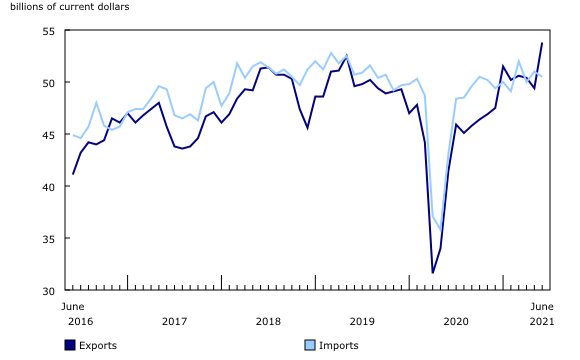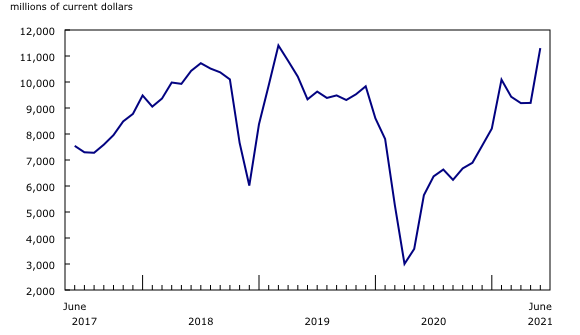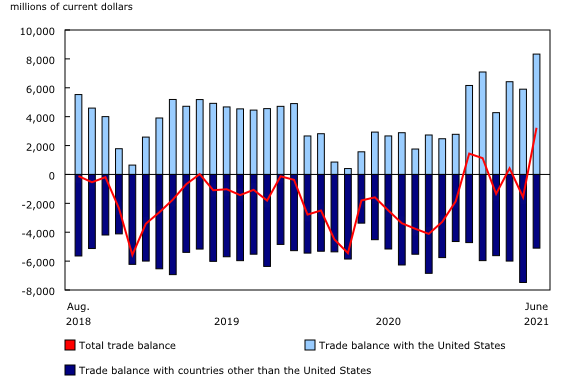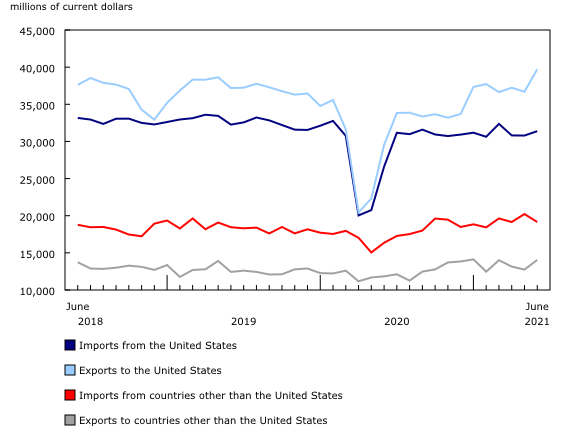Canadian international merchandise trade, June 2021
Archived Content
Information identified as archived is provided for reference, research or recordkeeping purposes. It is not subject to the Government of Canada Web Standards and has not been altered or updated since it was archived. Please "contact us" to request a format other than those available.
Released: 2021-08-05
In June, a sharp increase in exports resulted in Canada's merchandise trade balance returning to a surplus position, reaching $3.2 billion. This follows a $1.6 billion deficit in May. Exports of goods rose 8.7% in June, while imports decreased 1.0%.
Consult the "International trade monthly interactive dashboard" to explore the most recent results of Canada's international trade in an interactive format.
Record high in exports
Total exports reached a record $53.8 billion in June, up 8.7% or $4.3 billion compared with the previous month. Excluding the strong fluctuations of 2020, the increase in value in June was the largest on record. Exports were up in 9 of the 11 product sections and non-energy exports rose 5.5%. In real (or volume) terms, total exports increased 7.0%.
Exports of energy products (+22.9%) increased sharply to $11.3 billion in June, the highest level since March 2019. The $2.1 billion rise, which accounted for almost half of the gain in total exports, was mainly attributable to a 25.7% increase in crude oil exports. While crude oil prices increased in June, the rise in export value was mainly the result of higher volumes, which were up following a slowdown in crude oil production in Canada in April and May. Exports of refined petroleum energy products (+37.1%) and natural gas (+23.3%) also increased in June.
Exports of motor vehicles and parts rose 14.9% in June. Following recent monthly declines related to shutdowns caused by supply chain issues (in particular the global microchip shortage), exports of passenger cars and light trucks increased 24.6% in June. Work stoppages at Canadian assembly plants in June were less severe than in April and May. Despite the monthly gain, exports of passenger cars and light trucks remained more than 8% lower than in June 2020, when the Canadian auto industry had not yet fully recovered from the pandemic-related lockdowns.
Exports of metal and non-metallic mineral products increased 12.7% in June to a record $6.7 billion. Exports of unwrought gold, silver, and platinum group metals, and their alloys—a category mainly composed of gold—contributed the most to the gain. These were up 23.2%, mostly on higher exports of gold to Hong Kong and the United Kingdom. Higher asset transfers within the banking sector and increased sales of refined gold were behind these gains in June. Exports of unwrought aluminum and aluminum alloys (+19.0%) also rose in June, mostly on higher exports to the United States and the Netherlands.
Offsetting movements in imports
Total imports decreased 1.0% in June to $50.5 billion. Imports were down in 7 of the 11 product sections. In real (or volume) terms, total imports fell 2.2% in June.
Imports of consumer goods (-3.7%) contributed the most to the overall decline in June. Following a 16.5% increase in May, imports of miscellaneous goods and supplies (-18.7%) posted the largest decrease. This product group, which includes a wide range of goods, fell on lower imports of articles of precious metals from the United States, and lower imports of personal protective equipment. Imports of clothing, footwear and accessories (-26.6%) also decreased in June amid retail restrictions in parts of Canada and port disruptions in Asia related to COVID-19 outbreaks. These declines were partially offset by higher imports of pharmaceutical and medicinal products (+24.5%), which reached a record high in June on higher imports of "vaccines for human medicine other than for influenza." Imports in this category, which include COVID-19 vaccines, rose 74.5% to $745 million (on a customs basis and not seasonally adjusted), a value 21 times higher than in June 2020.
Imports of motor vehicles and parts decreased 3.8% in June. After an increase of 7.7% in May, imports of passenger cars and light trucks fell 9.0% in June, mainly on lower imports from countries other than the United States. After being heavily affected in 2020 by forced closures related to the pandemic, the global auto industry is currently dealing with a significant shortage of parts, which has been slowing down Canadian imports of passenger cars and light trucks. In the second quarter of 2021, imports of passenger cars and light trucks decreased 24.4%.
Partially offsetting these declines, imports of aircraft and other transportation equipment and parts rose 28.0% in June. Aircraft imports (+$458 million) were behind this increase, with five new commercial airliners as well as three cargo aircraft imported in June.
Higher surplus with the United States, lower deficit with countries other than the United States
Exports to the United States rose 8.2% to a record $39.7 billion in June, supported by higher exports of crude oil and of passenger cars and light trucks. Imports from the United States increased 1.9%. As a result, Canada's trade surplus with the United States widened from $5.9 billion in May to $8.3 billion in June, the largest surplus since August 2008.
When the average exchange rates of May and June are compared, the Canadian dollar lost 0.7 US cents relative to the American dollar.
Exports to countries other than the United States increased 10.2% in June, with higher exports to Hong Kong (gold), the Netherlands (aluminum, iron ores and crude oil), China (copper ores and canola), and the United Kingdom (gold).
Imports from countries other than the United States decreased 5.3% in June, with declines observed for most Asian countries that are included in the principal trading partner classification. Imports from China (-9.6%) posted the largest decrease, which coincided with port disruptions in China in June related to COVID-19 outbreaks.
Canada's trade deficit with countries other than the United States narrowed from a record $7.5 billion in May to $5.1 billion in June.
Decline in trade of motor vehicles and parts limits quarterly growth
Following an 8.1% increase in the first quarter of 2021, total exports rose 0.8% to a record $153.6 billion in the second quarter. Higher exports of forestry products (+15.1%) and energy products (+7.1%) were partially offset by a sharp decline in exports of motor vehicles and parts (-14.8%).
Quarterly imports edged up 0.3% to $151.5 billion in the second quarter of 2021. Lower imports of motor vehicles and parts (-18.4%) were offset by increases in several other product sections, including basic and industrial chemical, plastic and rubber products (+14.3%) and metal and non-metallic mineral products (+11.1%).
Canada's quarterly merchandise trade surplus went from $1.2 billion in the first quarter of 2021 to $2.1 billion in the second quarter.
Exports in constant dollars (using the Fisher formula) fell 4.7% in the second quarter, while quarterly imports in constant dollars were down 0.6%.
Revisions to May merchandise export and import data
Imports in May, originally reported at $50.9 billion in the previous release, were revised to $51.0 billion in the release for the current reference month. Exports in May, originally reported at $49.5 billion in the previous release, were revised to $49.4 billion in the current month's release.
Monthly trade in services
In June, monthly service exports edged down 0.1% to $9.3 billion. Service imports increased 3.5% to $10.0 billion.
When international trade in goods and international trade in services were combined, exports rose 7.4% to $63.0 billion in June, while imports decreased 0.2% to $60.5 billion. As a result, Canada's trade balance with the world for goods and services went from a deficit of $2.0 billion in May to a surplus of $2.5 billion in June.
Upcoming release of the new Canadian International Merchandise Trade Web Application
In the fall of 2021, Statistics Canada will launch the Canadian International Merchandise Trade (CIMT) Web Application, which will replace the existing online CIMT database. This modernized tool will provide users with a number of enhancements, including access to the full 8-digit (exports) and 10-digit (imports) Harmonized System product categories, as well as insights on CIMT in a more user-friendly, efficient and visually appealing manner. Watch this video to learn more about the added data and features.
Note to readers
Merchandise trade is one component of Canada's international balance of payments (BOP), which also includes trade in services, investment income, current transfers, and capital and financial flows.
International trade data by commodity are available on both a BOP and a customs basis. International trade data by country are available on a customs basis for all countries and on a BOP basis for Canada's 27 principal trading partners (PTPs). The list of PTPs is based on their annual share of total merchandise trade—imports and exports—with Canada in 2012. BOP data are derived from customs data by adjusting for factors such as valuation, coverage, timing and residency. These adjustments are made to conform to the concepts and definitions of the Canadian System of National Accounts.
For a conceptual analysis of BOP-based data versus customs-based data, see "Balance of Payments trade in goods at Statistics Canada: Expanding geographic detail to 27 principal trading partners."
For more information on these and other macroeconomic concepts, see the Methodological Guide: Canadian System of Macroeconomic Accounts (13-607-X) and the User Guide: Canadian System of Macroeconomic Accounts (13-606-G).
The data in this release are on a BOP basis and are seasonally adjusted. Unless otherwise stated, values are expressed in nominal terms, or current dollars. References to prices are based on aggregate Paasche (current-weighted) price indexes (2012=100). Movements within aggregate Paasche prices can be influenced by changes in the share of values traded for specific goods, with sudden shifts in trading patterns—as observed currently with the COVID-19 pandemic—sometimes resulting in large movements in Paasche price indexes. Volumes, or constant dollars, are calculated using the Laspeyres formula (2012=100), unless otherwise stated.
For information on seasonal adjustment, see Seasonally adjusted data – Frequently asked questions.
Revisions
In general, merchandise trade data are revised on an ongoing basis for each month of the current year. Current-year revisions are reflected in both the customs-based and the BOP-based data.
The previous year's customs-based data are revised with the release of data for the January and February reference months, and thereafter on a quarterly basis. The previous two years of customs-based data are revised annually, and revisions are released in February with the December reference month.
The previous year's BOP-based data are revised with the release of data for the January, February, March and April reference months. To remain consistent with the Canadian System of Macroeconomic Accounts, revisions to BOP-based data for previous years are released annually in December with the October reference month.
Factors influencing revisions include the late receipt of import and export documentation, incorrect information on customs forms, the replacement of estimates produced for the energy section with actual figures, changes in merchandise classification based on more current information, and changes to seasonal adjustment factors.
For information on data revisions for exports of energy products, see Methodology for Exports of Energy Products within the International Merchandise Trade Program.
Revised data are available in the appropriate tables.
Real-time data table
The real-time data table 12-10-0120-01 will be updated on August 16, 2021.
Next release
Data on Canadian international merchandise trade for July will be released on September 2, 2021.
Products
The product "International trade monthly interactive dashboard" (71-607-X) is now available. This new interactive dashboard is a comprehensive analytical tool that presents monthly changes in Canada's international merchandise trade data on a balance-of-payments basis, fully supporting the information presented every month in the Daily release.
The product "The International Trade Explorer" (71-607-X) is now available online.
Customs-based data are now available in the Canadian International Merchandise Trade Database (65F0013X).
The updated "Canada and the World Statistics Hub" (13-609-X) is now available online. This product illustrates the nature and extent of Canada's economic and financial relationship with the world using interactive graphs and tables. It provides easy access to information on trade, investment, employment and travel between Canada and a number of countries, including the United States, the United Kingdom, Mexico, China, Japan, Belgium, Italy, the Netherlands and Spain.
Contact information
For more information, contact us (toll-free 1-800-263-1136; 514-283-8300; STATCAN.infostats-infostats.STATCAN@canada.ca).
To enquire about the concepts, methods or data quality of this release, contact Benoît Carrière (613-951-4636; STATCAN.mediahotline-ligneinfomedias.STATCAN@canada.ca), International Accounts and Trade Division.
- Date modified:










